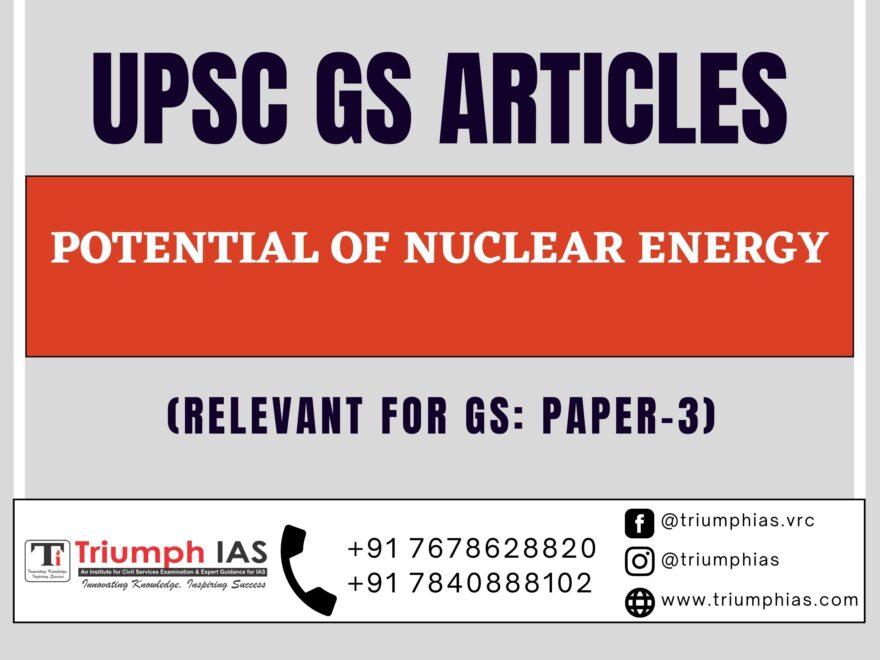Potential of nuclear energy
(GS PAPER-3)

Nuclear energy is the power that is contained within the nucleus or central region of an atom. All matter in the universe is made up of atoms, which are minute building blocks, and energy is the force that keeps the nucleus intact. The nucleus of an atom contains an immense quantity of energy, which is known as the “strong force.”
Relevancy of nuclear energy
There is debate over the continued relevance of nuclear power in a future that is free of fossil fuels, especially in India where safety and cost issues are ongoing. As renewable energy sources like solar and wind power become increasingly popular worldwide, the cost of nuclear fuel remains a significant burden on the country’s finances.
- Germany has recently shut down its last nuclear power plant, and France is facing challenges in replacing its old reactors, despite being a significant nuclear energy producer.
- Nuclear power is advantageous in that it provides a low-carbon, dependable, and secure source of energy.
- However, it also poses challenges related to reactor safety and the safe disposal of nuclear waste.
- In addition, the supply of nuclear fuel is a limiting factor in the expansion of nuclear energy.
Current Status of Nuclear Power Globally
After the Ukraine war, there has been a resurgence in nuclear power, with various countries in Europe and the USA increasing the proportion of nuclear energy in their overall energy mix.
- The President of South Korea has modified the country’s energy policy and pledged to raise the proportion of nuclear power in the energy mix to 30% by 2030.
- Japan, which was expected to shut down all reactors following the Fukushima disaster, is resuming the operation of nuclear reactors as a means of diversifying from coal and natural gas.
- Currently, 10 nuclear reactors have been restarted in Japan, with an additional 17 in the planning stages.
Status of Nuclear Energy in India
- Nuclear power constitutes the fifth-largest source of electricity in India, contributing approximately 2% to the nation’s overall power generation.
- India currently has seven power plants with over 22 nuclear reactors that collectively generate 6,780 MW of nuclear energy.
- Among these reactors, 18 are Pressurised Heavy Water Reactors (PHWRs) while the remaining 4 are Light Water Reactors (LWRs).
- In January 2021, the Kakrapar Atomic Power Project (KAPP-3), which is India’s first 700 MWe unit and the largest indigenously developed PHWR variant, was connected to the grid.
- The Indian government has authorized joint ventures between the Nuclear Power Corporation of India Limited (NPCIL) and public sector undertakings (PSUs) to promote the country’s nuclear program. NPCIL is presently collaborating with the National Thermal Power Corporation Limited (NTPC) and the Indian Oil Corporation Limited (IOCL).
Importance of nuclear energy
Although managing radioactive fuel and disposal can be costly, nuclear power plants are less expensive to operate than coal or gas plants. India’s significant Thorium resources make nuclear energy a promising solution for the country’s energy needs, as Thorium is considered the fuel of the future. India is a leading country in Thorium availability.
- Nuclear energy has the potential to reduce India’s import bills by $100 billion annually, which is currently spent on importing coal and petroleum.
- Dispatchable power, also known as firm power, is a type of power that can be provided to the electric grid whenever required. It can be turned on or off based on demand.
Challenges in nuclear energy
- India’s nuclear plan is focused on overcoming its limited supply of enriched uranium, which is costly and challenging to obtain.
- The nuclear industry is shifting towards “passive safety” designs for nuclear reactors, which are safer than older designs of nuclear plants.
- Nuclear power produces nuclear waste, which can have severe negative impacts on life, such as cancerous growths and genetic issues for multiple generations of animals and plants.
- India needs to adopt a well-rounded strategy that tackles the obstacles and potentials of the energy sector and facilitates the development of a mix of dependable, steady, and eco-friendly energy sources.
Follow us :
-
🔎 https://www.instagram.com/triumphias
🔎https://www.youtube.com/c/TriumphIAS
https://t.me/VikashRanjanSociology
Find More Blogs
Scope of the subject and comparison with other social sciences
Changing family structure in India Modernity and social changes in Europe
nuclear energy, India, dispatchable power, import bills, renewable energy, uranium, passive safety, nuclear waste, challenges, potentials.#Sociologyforupsc #sociologyforupscinhindi #sociologyforupscgs1 #sociologyforupscprelims #sociologyforupscinenglish #sociologyforupscmainsinhindi #sociologyforupscoptionalinhindi #sociologyforupscmains #sociologyforupscplaylist #sociologyforupsclecture1 #sociologyforupsccse #sociologyforupscoptional #syllabusofsociologyforupscoptional #bestbookforsociologyforupsc #sociologyoptionalforupscanswerwriting #sociologyoptionalforupscanukumari #sociologyoptionalforupscabhijeet #sociologyoptionalforupscanalysis #sociologyoptionalforupscalllectures #sociologysyllabusforupscanalysis

